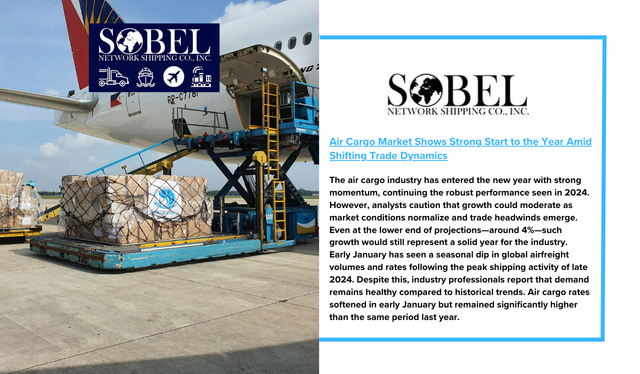The air cargo industry has entered the new year with strong momentum, continuing the robust performance seen in 2024. However, analysts caution that growth could moderate as market conditions normalize and trade headwinds emerge. Even at the lower end of projections—around 4%—such growth would still represent a solid year for the industry.
Early January has seen a seasonal dip in global airfreight volumes and rates following the peak shipping activity of late 2024. Despite this, industry professionals report that demand remains healthy compared to historical trends. Air cargo rates softened in early January but remained significantly higher than the same period last year.
Rates along key trade corridors, particularly between China and North America, have declined less than usual from their December highs. Reports indicate that pricing out of major hubs like Shanghai and Hong Kong has decreased by approximately 20.5%, compared to a historical average drop of 26% for this period.
Logistics providers have observed a resurgence in volumes following a brief slowdown at the end of December. Analysts attribute this to factors such as companies stockpiling inventory ahead of potential trade policy shifts and an earlier-than-usual Lunar New Year, which begins on January 29. Businesses often front-load shipments to mitigate potential delays caused by factory closures in Asia, a seasonal occurrence that can disrupt supply chains for weeks.
The end of 2024 saw exceptionally strong performance, with minimal declines in late December. Some industry reports highlight that the final two weeks of the year outperformed expectations, leading to record-high load factors for that time of year. This trend has carried into early January, with air cargo networks showing resilience despite fluctuations across different regions.
Industry updates indicate that airfreight demand for consumer electronics surged in mid-December, defying traditional market patterns where demand typically slows after the first week of the month. Some logistics firms suggest this shift may indicate evolving shipping strategies that could persist into 2025, as companies optimize capacity and costs differently than in previous years.
December’s air cargo demand rose 11% year over year, while capacity increased by just 2%, pushing global spot rates up by 15% to nearly $3 per kilogram. This marked the fourteenth consecutive month of double-digit growth, with total 2024 volumes climbing 12%. However, growth moderated slightly in the final quarter due to more challenging year-over-year comparisons as the market stabilized.
Certain trade routes, particularly between Europe and North America, saw notable rate increases, with spot prices rising 21% in December. This spike has been linked to seasonal reductions in passenger airline capacity, which limit available cargo space, as well as freighter aircraft being repositioned to serve high-demand Asian markets.
Meanwhile, air cargo yields continued their upward trajectory, rising 7.8% in November and remaining over 50% higher than pre-pandemic levels. Several factors contributed to the market’s strength, including ongoing geopolitical disruptions that forced companies to reroute time-sensitive shipments via air, restricted airspace over Russia that lengthened flight times and reduced capacity, and a surge in e-commerce exports from China.
Major airlines experienced a strong fourth quarter, with cargo revenues climbing across multiple carriers. The rapid growth of e-commerce continues to be a primary driver of air cargo demand, with industry experts estimating that over half of Asia’s airfreight volume last year was tied to online retail. Large digital marketplaces securing dedicated air cargo space has further constrained capacity for traditional freight shipments, putting upward pressure on rates.
Shippers increasingly moved toward longer-term airfreight contracts in 2024, with agreements spanning one year or more accounting for 63% of transactions in the fourth quarter—a significant increase from the previous year. At the same time, freight forwarders continued to negotiate a substantial portion of their volumes in the spot market, leading to pricing challenges as airlines adjusted their selling rates. Looking ahead, carriers have announced an expected 10% increase in airfreight contract rates for 2025.
Market Caution for 2025
Despite the strong start to the year, industry analysts anticipate that air cargo growth will moderate to between 4% and 6% in 2025. Several factors could dampen demand, including shifts in global trade policies, geopolitical tensions, and changes in ocean freight dynamics.
A resumption of shipping through key maritime trade routes, including the Suez Canal, could reduce demand for expedited air shipments. Additionally, a softening manufacturing sector, increasing protectionist trade measures, and potential regulatory changes affecting direct-to-consumer e-commerce shipments could all influence air cargo volumes in the coming months.
One potential disruption was averted this month, as a long-term labor agreement was reached at major U.S. ports, eliminating the risk of supply chain disruptions that could have led to increased demand for air transport.
While the overall market remains robust, industry stakeholders will be closely monitoring these evolving conditions to assess their impact on air cargo demand and pricing in 2025.


